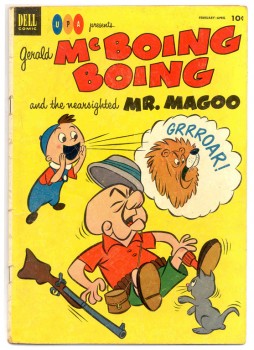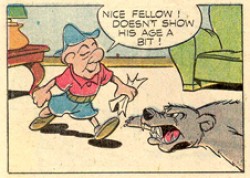Animation Artifacts &UPA 26 Mar 2006 08:41 am
UPA of the Past
 – There’s been a lot made about UPA these past few weeks because of the upcoming show in Hollywood at The Egyptian Theater (today). Rightly so, they did some great work in their early years.
– There’s been a lot made about UPA these past few weeks because of the upcoming show in Hollywood at The Egyptian Theater (today). Rightly so, they did some great work in their early years.
But we have to remember that once they reached their pinnacle during the early fifties, they sort of STOPPED and kept running in place. After teaching the world that 20th century graphics worked in animation – unlike the model set by Disney et. al. – they stopped in their Steinberg phase. Magoo kept puddle jumping, and after the first McBoing Boing, they broke little ground with the character.
It took till the late fifties for me to catch up to them, so I’m glad they ran in place for awhile. I loved Magoo’s Christmas Carol, regardless how limited its animation was. I even watched the Dick Tracy show as a kid and was happy that it looked different than Little Audrey and Popeye. But if we look seriously at the history of animation, we have to say that ART stopped happening at UPA after Unicorn In The Garden, The Telltale Heart and Madeline.
 – Dave Hilberman and Zach Schwartz had left the studio because of a control issue in the studio. John Hubley eventually was forced out for fhis political beliefs and another attempt to control the studio.
– Dave Hilberman and Zach Schwartz had left the studio because of a control issue in the studio. John Hubley eventually was forced out for fhis political beliefs and another attempt to control the studio.
Hilberman and Schwartz started Tempo, a commercial production studio in NYC, in 1947 and continued working until McCarthyism hit and closed their studio. Hubley eventually started Storyboard, also to produce commercials. However, Hubley started work on Finian’s Rainbow, an animated feature that, from the look of the remaining art and soundtrack tapes, was certainly a push forward for the ART of animation. That, too, was ultimately killed by Joseph McCarthy’s attempt to destroy civil liberties.
 Hubley moved to NY and began working in the style of the new art, abstract expressionism. UPA continued turning out cartoons in the style that they been stuck in for the rest of their history. They no longer were moving the ART forward, but were exploiting their reputation for the commercial interests.
Hubley moved to NY and began working in the style of the new art, abstract expressionism. UPA continued turning out cartoons in the style that they been stuck in for the rest of their history. They no longer were moving the ART forward, but were exploiting their reputation for the commercial interests.
In their initial days, UPA was the studio that changed the world of animation. The films they did in those days are the ones celebrated at events like today’s. It’s wonderful that those films are still alive and being seen. It’s too bad the studio didn’t go further; maybe they’d still be around.
- Today’s NYDaily News has an article about animation features by lead resident critic, Jack Mathews. Talk about art!

on 26 Mar 2006 at 11:07 am 1.Jerry Beck said …
Actually, I don’t completely agree with you that UPA stopped being vital after their early 50s pinnacle. I’d argue they started their artistic decline somewhere between THE BOING BOING SHOW in 1956 and the production of 1001 ARABIAN NIGHTS. The missing pieces of the puzzle are the commercials, the industrial films and the 80 random shorts produced for the CBS’ BOING BOING show during that period. While it’s true Hubley and the other guiding lights left the studio, the films made for the BOING BOING program were quite “on the edge” (particularly radical when you consider they were producing progressive TV animation before the field was even established!). Emerging talent such as Ernest Pintoff, Fred Crippen, Gene Deitch, John Whitney, and George Dunning joined the studio and made cleve, artistic films for this series. Veteran animation artists such as Rod Scribner, T. Hee, Art Heineman, and Rudy Larriva were given their first chance to direct short films for it as well. For decades, most of this material has been unavailable for review by interested animators and historians and left out of the equation (we are running a few of the best ones at tonight’s UPA Tribute in LA). The industrials and commercials from the mid-fifties may not have been ground-breaking, but they were the best in the business at the time. I don’t know for sure, but I think the production of 1001 ARABIAN NIGHTS was the breaking point for UPA. The decision to grow the studio and take Disney on in his own playing field was too great a pressure to withstand. The loss of the Columbia Pictures shorts deal also played into the demise of Bosustow’s dreams.
on 26 Mar 2006 at 1:09 pm 2.Michael said …
Of course, everything I’m saying is subjective. It took a long time for UPA to fall, but I think from ’53 on it was a slow fall.
I agree that a lot of talented people worked at the studio (even after 1001 Arabian Nights), but I’d question any of the product as anything truly ground breaking. These films did cement UPA’s reputation during that time, but the stories often were trivial and the designs weren’t as daring as the earlier films were.
Magoo was the staple, and much of the product was Magoo. It was good but nothing beyond what the original Magoo films were.
I own a number of prints of films from the Boing Boing show and though creative for tv product, they were limited in every way possible. I don’t think there’s a gaping hole in the history of animation.
on 26 Mar 2006 at 9:08 pm 3.Henry Lowengard said …
Shamus Culhane claims that Hubley did a “Producers” trick of paying more than 100% of points, to make the soundtrack for FINIAN’S RAINBOW in order to get the high priced talent (Sinatra, Armstrong, Fitzgerald, etc.) to participate, which may also have contributed to that film’s demise or at least have provided a convenient excuse to dump the project. As you mentioned, bootlegs of the sound track are available – but I don’t have one.
That said, Hubley made a number of great films with top jazz professionals that I think was mutually and artistically beneficial.
on 30 Mar 2006 at 5:39 pm 4.Michael said …
Hubley wasn’t the producer, but the director. it’s doubtful he negotiated such fees. Here’s a quote I found on-line which tells why Finian’s Rainbow was shut down:
“In 1955 work was abruptly halted on production of John Hubley’s animated feature-length version of Finian’s Rainbow which was to feature the voices of Louis Armstrong, Ella Fitzgerald, Ella Logan, and Frank Sinatra, among others; it was killed, according to John Canemaker, by Roy Brewer, head of the International Alliance of Theatrical Stage Employees union (IATSE), after Hubley refused to appear and name names before the McCarthyite Hollywood Committee. After Hubley’s refusal, Chemical Bank, the film’s principal investor, withdrew all financial support.” see link
This comes from John Canemaker’s difinitive article in Print Magazine entitled “Lost rainbow” : Print 47 Mar/Apr (1993):
on 21 Jul 2007 at 5:17 pm 5.AnneMarie said …
Hi Michael, How are you? I’m doing a piece based on 50′s style animation – UPA essentially.In trying to get ideas for backgrounds I happened across your page Thought I’d say Hi and thanks for the above!See you soon hopefully.
Thought I’d say Hi and thanks for the above!See you soon hopefully.
AnneMarie